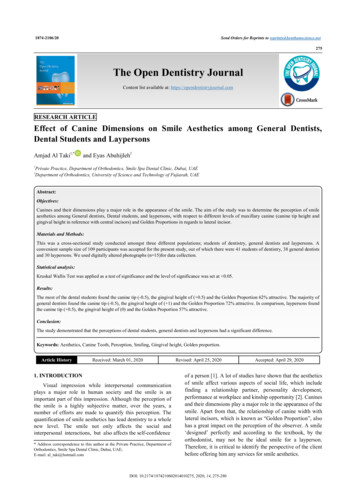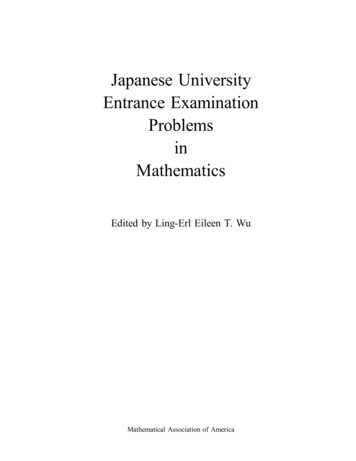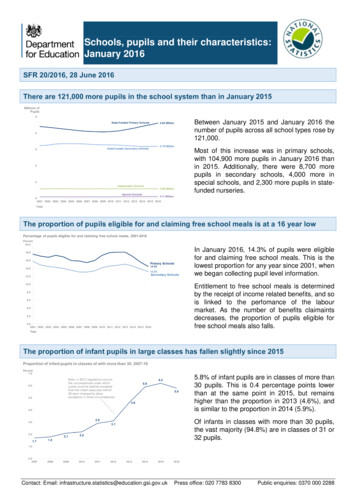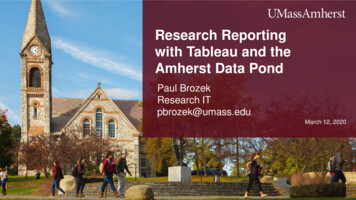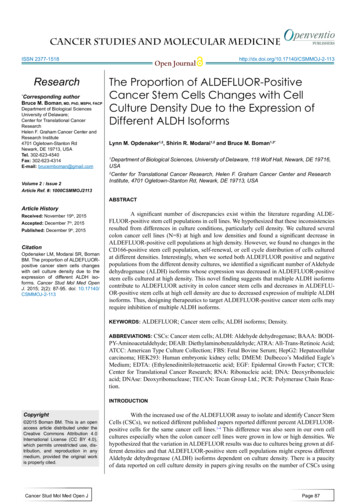
Transcription
CANCER STUDIES AND MOLECULAR MEDICINEISSN 2377-1518Research*Corresponding authorBruce M. Boman, MD, PhD, MSPH, FACPDepartment of Biological SciencesUniversity of Delaware;Center for Translational CancerResearchHelen F. Graham Cancer Center andResearch Institute4701 Ogletown-Stanton RdNewark, DE 19713, USATel. 302-623-4540Fax: 302-623-4314E-mail: brucemboman@gmail.comOpen Journalhttp://dx.doi.org/10.17140/CSMMOJ-2-113The Proportion of ALDEFLUOR-PositiveCancer Stem Cells Changes with CellCulture Density Due to the Expression ofDifferent ALDH IsoformsLynn M. Opdenaker1,2, Shirin R. Modarai1,2 and Bruce M. Boman1,2*Department of Biological Sciences, University of Delaware, 118 Wolf Hall, Newark, DE 19716,USA1Center for Translational Cancer Research, Helen F. Graham Cancer Center and ResearchInstitute, 4701 Ogletown-Stanton Rd, Newark, DE 19713, USA2Volume 2 : Issue 2Article Ref. #: 1000CSMMOJ2113ABSTRACTArticle HistoryReceived: November 19th, 2015Accepted: December 7th, 2015Published: December 9th, 2015CitationOpdenaker LM, Modarai SR, BomanBM. The proportion of ALDEFLUORpositive cancer stem cells changeswith cell culture density due to theexpression of different ALDH isoforms. Cancer Stud Mol Med OpenJ. 2015; 2(2): 87-95. doi: 10.17140/CSMMOJ-2-113A significant number of discrepancies exist within the literature regarding ALDEFLUOR-positive stem cell populations in cell lines. We hypothesized that these inconsistenciesresulted from differences in culture conditions, particularly cell density. We cultured severalcolon cancer cell lines (N 8) at high and low densities and found a significant decrease inALDEFLUOR-positive cell populations at high density. However, we found no changes in theCD166-positive stem cell population, self-renewal, or cell cycle distribution of cells culturedat different densities. Interestingly, when we sorted both ALDEFLUOR positive and negativepopulations from the different density cultures, we identified a significant number of Aldehydedehydrogenase (ALDH) isoforms whose expression was decreased in ALDEFLUOR-positivestem cells cultured at high density. This novel finding suggests that multiple ALDH isoformscontribute to ALDEFLUOR activity in colon cancer stem cells and decreases in ALDEFLUOR-positive stem cells at high cell density are due to decreased expression of multiple ALDHisoforms. Thus, designing therapeutics to target ALDEFLUOR-positive cancer stem cells mayrequire inhibition of multiple ALDH isoforms.KEYWORDS: ALDEFLUOR; Cancer stem cells; ALDH isoforms; Density.ABBREVIATIONS: CSCs: Cancer stem cells; ALDH: Aldehyde dehydrogenase; BAAA: BODIPY-Aminoacetaldehyde; DEAB: Diethylaminobenzaldehyde; ATRA: All-Trans-Retinoic Acid;ATCC: American Type Culture Collection; FBS: Fetal Bovine Serum; HepG2: Hepatocellularcarcinoma; HEK293: Human embryonic kidney cells; DMEM: Dulbecco’s Modified Eagle’sMedium; EDTA: (Ethylenedinitrilo)tetraacetic acid; EGF: Epidermal Growth Factor; CTCR:Center for Translational Cancer Research; RNA: Ribonucleic acid; DNA: Deoxyribonucleicacid; DNAse: Deoxyribonuclease; TECAN: Tecan Group Ltd.; PCR: Polymerase Chain Reaction.INTRODUCTIONCopyright 2015 Boman BM. This is an openaccess article distributed under theCreative Commons Attribution 4.0International License (CC BY 4.0),which permits unrestricted use, distribution, and reproduction in anymedium, provided the original workis properly cited.Cancer Stud Mol Med Open JWith the increased use of the ALDEFLUOR assay to isolate and identify Cancer StemCells (CSCs), we noticed different published papers reported different percent ALDEFLUORpositive cells for the same cancer cell lines.1-4 This difference was also seen in our own cellcultures especially when the colon cancer cell lines were grown in low or high densities. Wehypothesized that the variation in ALDEFLUOR results was due to cultures being grown at different densities and that ALDEFLUOR-positive stem cell populations might express differentAldehyde dehydrogenase (ALDH) isoforms dependent on culture density. There is a paucityof data reported on cell culture density in papers giving results on the number of CSCs usingPage 87
CANCER STUDIES AND MOLECULAR MEDICINEISSN 2377-1518Open Journalthe ALDEFLUOR assay. However, there are a few articles andreviews that acknowledge that gene expression can change withrespect to the changing characteristics of stem cells observed atdifferent culture densities.5-9Aldehyde dehydrogenase (ALDH) is part of a family ofenzymes localized in the cytoplasm, mitochondria or nucleus.10In recent years, ALDH has been used to identify CSCs in various solid tumors and it has become a universal marker for CSCsin epithelial cancers.10,11 The ALDEFLUOR assay allows for theisolation of viable CSCs from patient tissue samples and for further analysis involving in vitro and in vivo studies. This assaymeasures the ALDH enzyme activity via cleavage of a fluorescent substrate, BODIPY-Aminoacetaldehyde (BAAA), that consists of an aminoacetaldehyde moiety bonded to the BODIPYfluorochrome.12 To measure the exact percent of cells with highALDH activity, an ALDH inhibitor, Diethylaminobenzaldehyde(DEAB), is used as a control.There are 19 known isoforms of ALDH and severalhave been implicated in different types of cancers. Isoformexpression is cell and tissue type dependent. In breast cancer,ALDH1, ALDH1A1, 1A3, and 3A1 have all been identified andcorrelated with aggression, progression, or poor survival.13-16ALDH1A3 has also been identified as the main isoform responsible for ALDEFLUOR activity in breast cancer cells.17 In ovarian cancer, ALDH1A1 overexpression was tumor-type specific.Overexpression of isoforms 1A3, 3A2 and 7A1 in ovarian cancerappear to be a more consistent finding.18 ALDH7A1 overexpression is reported to contribute to metastasis in prostate cancer.19Overexpression of ALDH3A1 has also been identified in prostate cancer and hepatocellular carcinoma. In colon, ALDH1B1was identified as a potential CSC biomarker in patient samples.20Particularly in colon, a pan-ALDH1 antibody has been used toidentify expression patterns. Expression of the ALDH1 familyin colon cancer cell lines and patient samples have been utilizedby several lab groups to identify and isolate CSCs.2,11,21,22 Whilemany isoforms have been identified as biomarkers and indicators of tumorigenicity and cancer progression, several other isoforms still remain to be investigated.Each of the different ALDH isoforms has a particularspecificity for different substrates linked to their role in cellularfunction. For example, ALDH1A1, ALDH1A2, ALDH1A3 andALDH8A1 have been linked to retinoic acid cell signaling viaretinoic acid production due to the oxidation of All-Trans-Retinoic Acid (ATRA) and 9-cis retinoic acid.23 The other isoformsare not directly related to retinoic acid signaling and instead haveslightly different roles. Their substrate preferences also dependon the intra-cellular location of the isoforms, as some isoformsare mitochondrial and others are found in the cytoplasm.In our current study, we analyzed colon cancer celllines cultured in low and high densities to ascertain the effectsof density on the ALDH population size via the ALDEFLUORCancer Stud Mol Med Open Jhttp://dx.doi.org/10.17140/CSMMOJ-2-113assay. Our goal was to investigate how density culture conditions contribute to changes to the ALDEFLUOR cell populationsize and whether or not this regulation occurs due to changes ina specific ALDH isoform, particularly one that might be uniqueto colon cancer cells. To our knowledge, this is the first report ofdensity differences observed with the ALDEFLUOR assay andan attempt of looking at the possible causes behind these differences.METHODSCell CultureHT29 and HCT116 cells obtained from American TypeCulture Collection (ATCC; Manassas, VA, USA) were grown inmonolayer cultures and maintained in: McCoys medium (GIBCO/Life Technologies) supplemented with 5% Fetal BovineSerum (FBS) and 100 units/ml penicillin and 100 ug/ml streptomycin (P/S). SW480 cells obtained from ATCC were maintained in Leibovitz’s 15 (L-15) medium (GIBCO/Life Technologies) supplemented with 5% FBS and P/S. LoVo, Colo320 andDiFi cells were maintained in Roswell Park Memorial Institute(RPMI-1640) medium (GIBCO/Life Technologies) supplemented with 5% FBS and P/S. Hepatocellular carcinoma (HepG2)and Human embryonic kidney cells (HEK293) cell lines weremaintained in Dulbecco’s Modified Eagle’s medium (DMEM)supplemented with 5% FBS and P/S. All cell cultures weremaintained at 37 C in humidified air at 5% CO2. To achieve thedesired low and high cell densities, cells were plated at 400,000cells/100 mm culture dish (Greiner, VWR International) for lowdensity and 800,000 cells/100 mm dishes for high density. Cellswere allowed to grow for 3-5 days until a confluency of 30-40%was achieved for low density and 70-80% was achieved for highdensity. Culture medium for all cell lines was changed every 48hours. Cell cultures never reached full confluency at the time ofanalysis. All experiments in this study were conducted withinten passages.ALDEFLUOR AssayProtocol was followed according to the manufacturer(STEMCELL Technologies). Briefly, cells were grown to 80%confluence and lifted using 0.25% Trypsin-EDTA (Fisher Scientific). Cells were spun for five minutes to pellet and washedonce with PBS. Cells were resuspended in ALDEFLUOR assaybuffer at a concentration of one million cells/ml. Two tubes werelabeled as control and sample. To the control tube, 5 μl of theDEAB inhibitor was added. To the sample tube, 5 μl of the activated ALDEFLUOR reagent was added, mixed and immediately500 μl of the suspension was taken out and put in the controltube with the inhibitor. Cells were incubated for 40 minutes at37 C. After incubation, cells were spun for five minutes to pelletand washed once with ALDEFLUOR buffer. Cell were resuspended in 500 μl ALDEFLUOR buffer and passed through a BDround bottom tube with a 50 μm cell strainer (BD Biosciences).Page 88
CANCER STUDIES AND MOLECULAR MEDICINEISSN 2377-1518Open JournalSamples were placed on ice and covered from light until readyfor analysis on the BD FACSAria II Flow Cytometer.Flow CytometryAll cells were grown to the appropriate low and highculture densities and lifted using an (Ethylenedinitrilo)tetraacetic acid (EDTA) based solution called Cell Stripper (Fisher Scientific). Cells were spun for five minutes to pellet and resuspended in a 3% BSA blocking solution made in PBS. Cells wereincubated for 1 hour on ice in this blocking solution before 5 μlof CD166-PE conjugated antibody (BD Biosciences) was added to the cells. An appropriate PE conjugated IgG control (BDBiosciences) was used at an equal concentration to the CD166antibody. Cells were incubated on ice for 30 minutes. Followingprimary antibody and IgG incubation, cells were washed twicewith PBS, and then resuspended in PBS. Cell suspensions werepassed through a BD round bottom tube with a 50 μm cell strainer (BD Biosciences). Cell surface staining was analyzed usingthe BD FACSAria II Flow t high and low densities. RNA was isolated using the TRIzolreagent (Thermo Fisher Scientific) and the protocol providedby the manufacturer. Briefly, cells were pelleted and lysed inTRIzol reagent. After a brief incubation at RT, chloroform wasadded and samples were incubated for 2-3 minutes at RT. Samples were centrifuged and the aqueous phase was removed. RNAwas precipitated with isopropyl alcohol, washed with ethanoland resuspended in sterile water. RNA was Deoxyribonuclease(DNAse) treated with the Deoxyribonucleic acid (DNA)-freeDNA Removal Kit (Ambion) per the manufacturer’s protocol.Concentration of the RNA was determined using the TecanGroup Ltd. (TECAN) Infinite 200 PRO microplate reader. Equalamounts of RNA were used for the reverse transcriptase reaction. Using the SuperScript III First-Strand Synthesis System(Life Technologies) and the provided protocol, complementaryDNA (Cdna) was generated. Polymerase Chain Reaction (PCR)was performed using 50 ng cDNA and the GoTaq Green PCRMastermix (Promega). Primers and reaction conditions for the19 ALDH isoforms were previously published.17 PCR productswere analyzed on a 1.5% agarose gel and imaged on the Syngeneimaging system.Colonosphere AssayCells were plated at a cell density of 200 cells per 100μl of stem cell media which is composed of serum free DMEM/F12 (GIBCO Inc.) with the addition of Epidermal Growth Factor (EGF) and basic Fibroblast Growth Factor (bFGF) and B-27complex without Vitamin A (Life Technologies, Carlsbad, CA,USA). The method and culture medium used to perform thecolonosphere assay was from a previously published article.24Ultra low attachment plates (BD Biosciences) were used for thisassay and colon spheres were analyzed for their size (diameter)and numbers per well on day ten using the 10x objective of aphase contrast microscope.Cell CycleCells were plated at low and high densities in 100 mmcell culture dishes and harvested using trypsin. The cells werewashed two times with PBS and then fixed in 1 mL ice cold 70%ethanol. Ethanol was added dropwise to the cells while vortexing to avoid clumping. Cells were fixed for at least 48 hoursbefore analysis and stored in 4 C until ready to stain with propidium iodide. When ready to stain and analyze samples, fixedcells were washed twice with PBS and spun down at 2000 rpmfor 5 minutes each time. Cells were resuspended in 1mL FxCycle PI/RNase staining solution (Invitrogen) and allowed toincubate for 15 minutes at room temperature and covered fromlight. Cells were transferred to a BD tube and analyzed on theBD FACSAria II Flow Cytometer with the PE channel.Reverse Transcriptase-Polymerase Chain ReactionRibonucleic acid (RNA) was isolated from ALDEFLUOR positive and negative sorted cells that were culturedCancer Stud Mol Med Open JStatisticsAll statistics were performed using Student’s t-test using Microsoft excel or a Paired t-test using Graph Pad Prismsoftware analysis.RESULTSOur laboratory observed significant variations in thepercent of ALDEFLUOR positive cells from one experiment tothe next and between scientist to scientist. In order to understandwhy such large variations occurred, we looked at several different cell lines and plated them at different cell densities (Figure1A). We found that when most cells were harvested at a lowerdensity (30-40%) they had a higher percent of ALDEFLUORpositive cells. However, when the cells were harvested at ahigher density (70-80%), but not confluent, the percent ALDEFLUOR activity was much lower (Figure 1B). This differencebetween the percent ALDEFLUOR positive cells in low andhigh density was statistically significant in 6 of the 8 cell lines(Figure 1C). The DiFi and HCT116 did show the same trendwith decreased ALDEFLUOR activity in high density cultures,but they did not reach a statistically significant difference in thepercent ALDEFLUOR positive cells between the two cell densities (Figure 1C).While the ALDEFLUOR assay is a commonly usedmethod to identify and isolate stem cells, another marker oftenused to identify colonic stem cells is CD166. To investigate ifthe changes we see in ALDEFLUOR activity at different densities correlates with changes in the stem cell population basedon another marker, we evaluated the percent of CD166 positivecells in three cell lines at low and high densities. In the three cellPage 89
CANCER STUDIES AND MOLECULAR MEDICINEISSN 2377-1518Open re 1: Cell density affects ALDEFLUOR activity without changing other stem cell characteristics. Representative images of HT29 and SW480 cells grown ay low (3040%) and high (70-80%) cell densities (A). It is important to note that the cells never reach full confluence before analysis. Cells from low and high density were culturedand ALDEFLUOR assay was performed. Representative histograms from one set of analysis on HT29 and SW480 cells grown at low and high density (B). Different coloncancer cell lines were cultured at low and high densities and ALDEFLUOR was performed. The average values of percent positive cells is graphed to show significantchanges in ALDEFLUOR positive cells at low and high densities (C). Expression of CD166 on three different colon cancer cell lines grown at low and high densities (D).Cells were grown at low and high density and then plated for colonosphere assay. Graph represents average number of spheres formed under each culture condition (E).All experiments were N 3 except ALDEFLUOR assay was performed with multiple relicates (N 10). * p 0.05, ** p 0.01, *** p 0.001.lines we studied, none of them showed differences in CD166 expression with cell density (Figure 1D). To further assess changesin the stem cell characteristics based on density differences, weperformed a colonosphere assay for self-renewal ability. Cellswere cultured under the conditions that yield high or low density, and at that point, the same number of cells derived fromeach culture condition was dissociated and plated for the sphereformation assay. After 10 days, there was no change in the number or sizes of the spheres formed from either condition (Figure1E). This indicates that whatever changes are occurring are culture dependent and when cells are removed from these culturingconditions, they do not retain the changes in the ALDH-positivestem cell population.The progression of cells through the cell cycle couldpossibility explain the decreased number of ALDEFLUOR positive cells at high density. Stem cells are believed to have slowcycling times as compared to other cell types found in the colonic epithelium. If the higher ALDEFLUOR positive population observed at low density is a result of increased number ofCancer Stud Mol Med Open Jstem cells, then fewer cells present in S phase would correlatewith this finding. However, at high density, there is no substantial change in the percent of cells at any of the stages of the cellcycle when compared to the lower density cultures (Figure 2).Based on these findings described above, we haven’tseen any change to explain why there is a higher percentage ofALDEFLUOR positive cells at lower cell densities. We then surmised that the level of ALDH expression might decrease at highdensity. In the literature, there are 19 different ALDH isoformsthat have been identified. Accordingly, we sorted out the ALDEFLUOR positive and negative populations from cells grown inboth the high and low density and performed PCR for each ofthe 19 isoforms. In HT29 cells, several isoforms were decreasedin the high density ALDEFLUOR positive populations (Figure3). Compared to the high density ALDH negative population,approximately 50% of the isoforms expressed show a decreasedpresence in the ALDH positive samples. Some of the same isoforms follow this pattern in the SW480 cells as well, but not tothe extent as seen in HT29 cells (Figure 3). Based on severalPage 90
CANCER STUDIES AND MOLECULAR MEDICINEISSN 2377-1518Open re 2: Cell cycle does not change with density. Cells were plated at low and high densities and then fixed before propidium iodide analysis. HT29 (A), SW480 (B), and HCT116 (C) cells were analyzed for different phases of the cell cycle andthere was no significant changes seen between each phase (N 3).Figure 3: Expression of several ALDH isoforms change with density in HT29 cells. Images are representative of RT-PCR data obtained from multiple experiments. All isoforms shown, except ALDH1A1,demonstrate reduced or absent expression in the high density ALDH positive samples.different sets of cells that were screened, the expression of the19 ALDH isoforms is summarized in Table 1. Our results indicate expression of several ALDH isoforms in colorectal cancerbecomes decreased at high density.DISCUSSIONLarge differences were observed in ALDEFLUORactivity between cell cultures grown in low and high densities. We evaluated several different colon cancer cell lines, aswell as HepG2 and HEK293 cells, and all lines except DiFi andHCT116 cells, showed a significant difference in ALDEFLUORCancer Stud Mol Med Open Jactivity when cultured at different densities. In the literature,there are many reports of different percentages of ALDH orALDEFLUOR positive cells in various colon cancer cell lines.In the current study we found SW480 cells have an average of38% ALDH positive cells in low density growth conditions and19% ALDH positive cells in high density conditions. In comparison, others have cited the SW480 cell population to havepercentages of ALDH positive cells approximately 17.5 0.07%which resemble our values for cultures grown in high densityconditions, or 48.3% ALDH positive cells which resemble moreof our cultures grown in low density conditions.3 HCT116 cellsalso had a wide range of ALDH positive cells, but while trendingPage 91
CANCER STUDIES AND MOLECULAR MEDICINEISSN en JournalHT29cells1A11A21A31B1LD- LD HD- HD 1L11L223A13A23B13B24A1 1A31B123A13A23B15A16A17A1 8A19A116A118A1 6A17A1 SW480cells1A11A2LDLD HD- HD 1L11L23B24A15A18A19A116A118A1 Table 1: Expression of ALDH isoforms in HT29 and SW480 cells. Reverse Transcriptase PCR was performed on RNA isolated from ALDH positive and negative populations sorted from high andlow density cultures. Particularly in the HT29 cell line, some isoforms are absent in the high density ALDH positive fraction. Plus ( ) signs indicate presence of a band for each replicate. Threereplicates were performed for the HT29 cell line and four replicates were performed for the SW480 cell line.to a decreased ALDEFLUOR positivity in high density cultures,HCT116 populations did not reach statistical significance inour analysis. However, in the literature, there is a large range ofHCT116 ALDH positive cells ( 4.0-49% ALDH positive) withno clear mention of culture density conditions.1-4 Overall, thesereports illustrate the discrepancy between the ALDEFLUOR assay and quantification of stem cell populations. Our data hereinshows a significant difference between the population of stemcells based on low and high density growth cultures. It is of interest to note that the experiments conducted in this study weredone within ten passages and based on our results there was nocorrelation between passage number and ALDEFLUOR activity. Our findings suggest a standard needs to be set, according tocell density, when performing experiments in order to be able tocompare experimental results on stem cell populations based onthe ALDEFLUOR assay.After discovering this change in ALDH positive cellsin low and high density cultures, we wanted to see if this difference translated to other colon cancer stem cell markers. Research suggests that there are several subpopulations of stemcells that reside within a tissue.25 Therefore, we looked specifically at CD166 expression since it is known that this is anothermarker for identification of colon cancer stem cells.26,27 We seethat CD166 and ALDH1 identify different sub-populations ofcolon CSCs as immunostaining marks distinct subsets of cells.Interestingly, the density-based changes we noted to be associated with ALDEFLUOR assay are unique to the sub-population ofALDH-positive cells, but not to the CD166-positive cells. Thus,the stem cells marked by high ALDEFLUOR activity appear tobe sensitive to changes in cell density, but the sub-population ofstem cells marked by CD166 expression is not affected.Since we saw a significant difference in ALDEFLUORCancer Stud Mol Med Open Jactivity in low and high density cultures, we examined sphereformation to corroborate the effect of density on the stem cellproperty of self-renewal of these cells. Colonosphere assaysshowed that no significant change occurred in sphere formationor sphere size with cell density.We then measured the distribution of cells in the different phases of the cell cycle between cells grown in low andhigh cell density. There was no statistically significant change inthe percent of cells in each phase of the cell cycle with differentdensity cultures. It is important to note that the cell cycle analysis shows cells are still proliferating at high density. It could bepossible that the cells are distributed similarly throughout thecell cycle, but that the time it takes the cells to transverse thecycle is slower.Up to this point we had not seen any changes betweencell cultures grown in low and high density other than the changein ALDEFLUOR assay. To try to discern what might cause theseobserved differences, we grew cells to low and high densityand then sorted the ALDEFLUOR positive and ALDEFLUORnegative populations to assess changes in the ALDH messengerRNA (mRNA) level. Although not widely published, researchers have observed changes in gene expression when cells arecultured at different densities.8 One group has looked at changesin gene expression in mesenchymal stem cells. They observedthat less dense cultures upregulate genes involved in proliferation and when the cultures become more confluent these genesare down-regulated and genes involved in secretion of cytokinesare upregulated.7 It is possible that this is similar in our cultures.At lower densities, genes involved in proliferation could be upregulated and increased stem cell population size could occurto maintain the proliferative capacity of the culture. At higherPage 92
CANCER STUDIES AND MOLECULAR MEDICINEISSN 2377-1518Open s densities, while still not yet confluent, cells could begin theprocess of maturation, thus causing the stem cell population sizeto contract.suppression and lowering the tumor’s self-renewal ability.In order to look at changes at the mRNA level of ALDEFLUOR positive and negative cells grown in low and highcell densities, we profiled the entire spectrum of ALDH isoforms. There are 19 different isoforms of ALDH and not onespecific type of isoform is linked directly to ALDEFLUOR assay, although the manufacturer Stem Cell Technologies Inc. reports that the assay was optimized for the ALDH1A1 isoform.However, based on our PCR data, there may be other isoformsresponsible for the ALDEFLUOR activity in colon cancer stemcells. Indeed, our study demonstrated the involvement of several isoforms previously not identified in colon cancer. Whiledata exists linking ALDH1B1 to colon cancer as a potential biomarker20 and modulator of the Wnt/β-catenin, Notch and PI3K/Akt signaling pathways,28 few other studies have looked specifically at this isoform. Changes in the ALDH1A3 isoform isinteresting, as this isoform has been linked to many other cancertypes and often follows the same pattern of ALDH1A1. In fact,ALDH1A3 was identified as the dominant isoform in breast cancer responsible for ALDEFLUOR activity.17 In colon cancer celllines, ALDH1A3 is upregulated in chemoresistant lines29 and itsregulation in chemoresistant lines may be due to changes in expression.30 While there is no data, to our knowledge, showingany links between ALDH4A1, ALDH6A1, and ALDH7A1 expression and colon cancer, our findings show changes in expression of these three isoforms at the mRNA level. Thus, it appearsthat the activity detected by the ALDEFLUOR assay may be attributed to several different isoforms. It is possible that identification of these other isoforms in CSCs will allow us other meansto distinguish colon CSCs from normal stem cells.The authors declare that have no conflicts of interests.CONCLUSIONOur study discovered a considerable effect of cell density on the degree of ALDH activity using the ALDEFLUOR assay. When cells are cultured in either low or high density there isa significant decrease in ALDH activity, but no drastic changesin CD166 positive cells, sphere formation, or cell cycle distribution. The fact that most of the cancer cell lines in this studyshowed a significant decrease in ALDH activity when culturedat high density, we surmised there must be a difference in thespecific isoform of ALDH that is expressed or not expressed. Indeed, our study identified several unique ALDH isoforms that aredifferentially expressed in ALDH positive cells that were grownat different densities. Moreover, our findings indicate that thereare different ALDH isoforms expressed that have not been previously linked to colorectal cancer. Results from our study couldopen up new approaches toward targeting colon CSCs. Effectivestem-cell-targeted treatments may result, not from the targeting of a single isoform, but multiple ALDH isoforms. Targetingand destroying different sub-populations of CSCs may necessitate inhibiting multiple ALDH isoforms, resulting in growthCancer Stud Mol Med Open JCONFLICTS OF INTERESTACKNOWLEDGEMENTSThe authors would like to thank the Center for Translational Cancer Research (CTCR) Core Facility at the Helen F. Graham Cancer Center and Research Institute for use of the BD FACSAria IIFlow Cytometer. We would like to thank the NIH NIGMS IDeAProgram (P20 GM103446) grant for support of the project, andCancer *B* Ware for the generous donation to support colorectal cancer research in the CTCR. Finally, the authors would liketo thank Dr. Nicholas Petrelli for his support of the project thatwas conducted at the CTCR.AUTHORS CONTRIBUTIONSAll authors meet the authorship requirements. LO, BB and SMcontributed to the design of the study. LO designed and LO andSM performed all of the in vitro experiments presented in thispaper. LO supervised all flow cytometry, cell so
2Center for Translational Cancer Research, Helen F. Graham Cancer Center and Research Institute, 4701 Ogletown-Stanton Rd, Newark, DE 19713, USA *Corresponding author Bruce M. Boman, MD, PhD, MSPH, FACP Department of Biological Sciences University of Delaware; Center for Translational Cancer Research Helen F.

